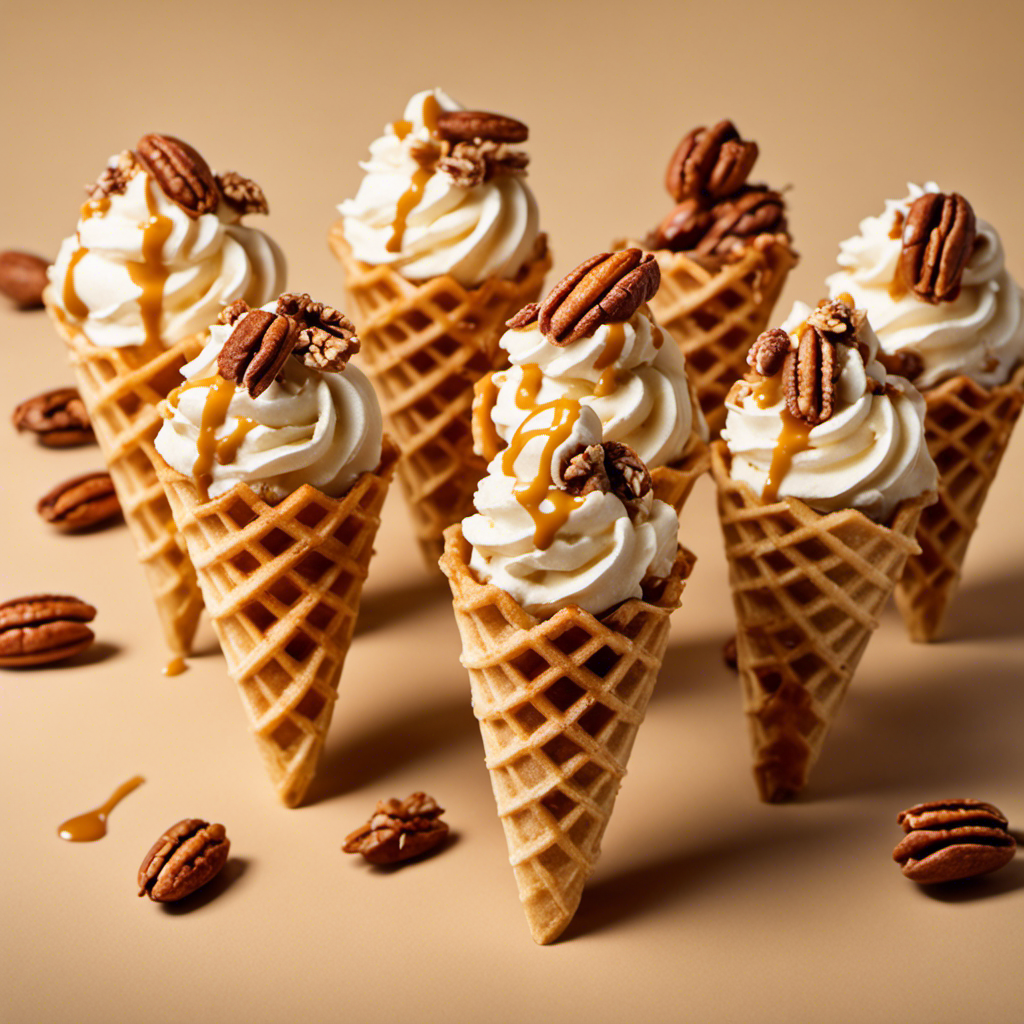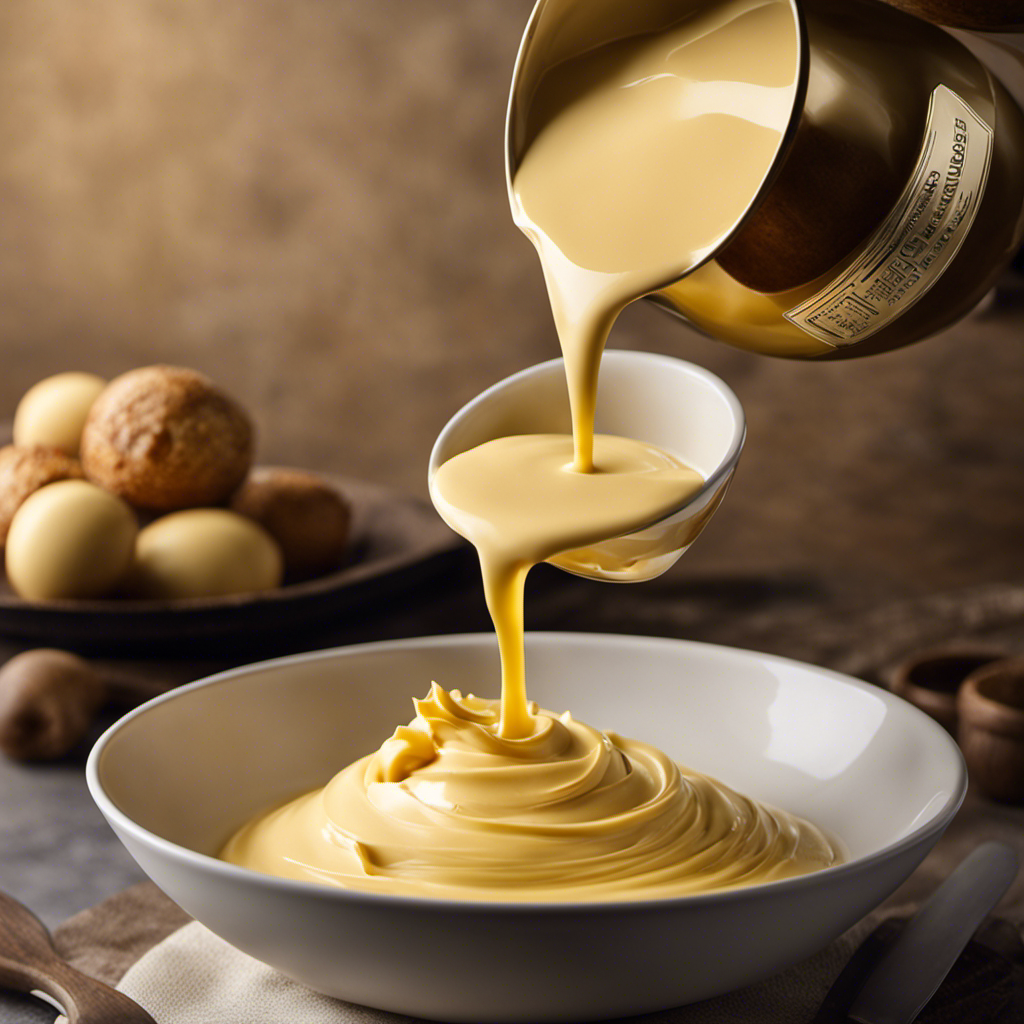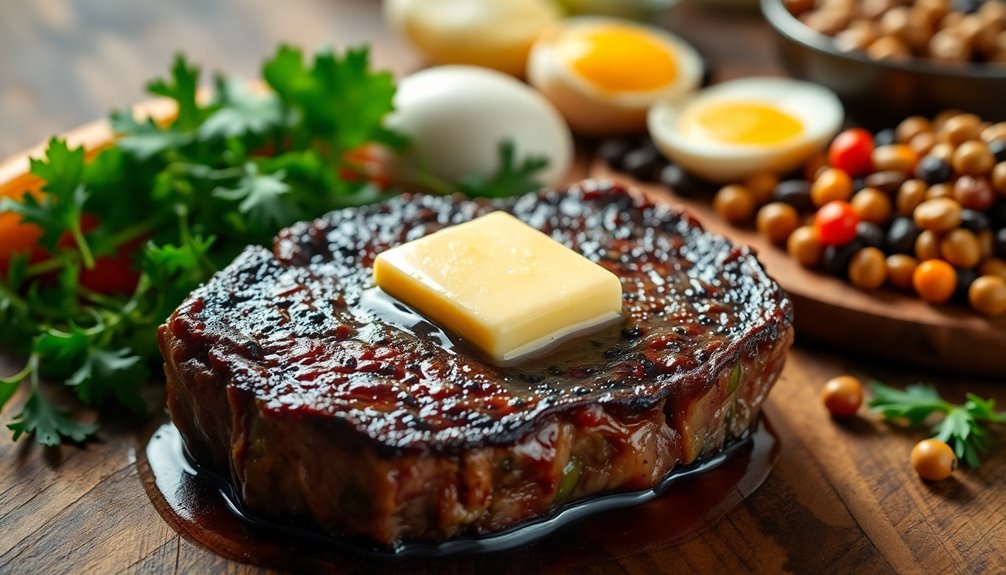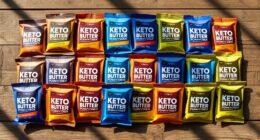I am not shy about my affection for sweet treats, and butter pecan is a flavor that never fails to satisfy. The combination of buttery richness and crunchy pecans creates a decadent treat that is simply irresistible.
In this article, we’ll dive into the world of butter pecan, exploring its origins, the ingredients used, and the process of making it.
Get ready to discover why butter pecan has become a beloved flavor in desserts and baked goods everywhere.
Key Takeaways
- Butter pecan originated in the southern United States and has a rich historical background as a classic flavor in the world of ice cream.
- The key ingredients in butter pecan ice cream are cream, sugar, and pecans, with cream providing a smooth base, sugar adding sweetness, and pecans adding a delightful crunch and buttery taste.
- Butter pecan pairs well with chocolate and caramel, and adding a hint of cinnamon can create a refreshing twist.
- Butter pecan is a popular flavor of ice cream that can be used in various desserts, and there are alternatives such as salted caramel pecan and toasted coconut pecan.
The Origin of Butter Pecan
The origin of butter pecan can be traced back to the southern United States. This delectable flavor is a classic in the world of ice cream, and it has a rich historical background.
The unique combination of buttery goodness and crunchy pecans creates a flavor profile that is both indulgent and satisfying. The origins of butter pecan can be attributed to the culinary traditions of the Southern states, where pecan trees are abundant.
The creamy texture and nutty taste of butter pecan ice cream have been enjoyed for generations, making it a beloved dessert choice. The flavor’s popularity has spread beyond the South, captivating taste buds across the country.
From its humble beginnings to its widespread appeal, butter pecan continues to be a timeless favorite.
Ingredients Used in Butter Pecan
To make butter pecan ice cream, all you need is a combination of delicious ingredients like cream, sugar, and pecans. These simple but flavorful ingredients come together to create a rich and creamy treat that is loved by many.
The cream provides the smooth and velvety base, while the sugar adds a touch of sweetness to balance the nutty flavor of the pecans. Speaking of pecans, they are the star of this ice cream, adding a delightful crunch and a rich, buttery taste. It’s no wonder that butter pecan is a popular flavor not only in ice cream but also in other desserts like butter pecan cookies.
Now that we know the key ingredients, let’s dive into the process of making butter pecan.
The Process of Making Butter Pecan
Now that you have all the ingredients, it’s time to start making your delicious butter pecan ice cream.
The first step is to roast the pecans. Roasting the pecans brings out their natural oils and intensifies their flavor, adding a rich and nutty taste to the ice cream. It’s important to keep a close eye on them while they’re in the oven, as they can burn easily.
Once the pecans are roasted, they are finely chopped and added to the ice cream base. The flavor profiles of butter pecan are a perfect balance of creamy butter and toasted pecans. The buttery notes provide a smooth and indulgent taste, while the pecans add a satisfying crunch.
The combination of these flavors creates a truly irresistible treat.
Variations of Butter Pecan
When it comes to flavor combinations, there are endless possibilities to explore and discover. From the classic pairings like chocolate and peanut butter, to the more unique combinations like lavender and honey, there is something for everyone’s taste buds.
In the world of desserts, these flavor combinations can really shine, adding depth and excitement to traditional treats like cupcakes, ice cream, and pies.
Unique Flavor Combinations
Combining sweet and nutty flavors, butter pecan is a unique and delicious flavor combination. When it comes to flavor pairings, butter pecan ice cream is a versatile treat that goes well with a variety of other flavors.
The creamy, buttery notes of the ice cream are perfectly complemented by the crunchy, toasted pecans. One classic pairing is butter pecan with chocolate. The rich, velvety chocolate adds a decadent twist to the buttery sweetness of the ice cream.
Another popular pairing is butter pecan with caramel. The smooth, sticky caramel enhances the nutty flavors of the pecans and adds a delightful sweetness. For a refreshing twist, try pairing butter pecan with a hint of cinnamon. The warm, spicy notes of the cinnamon perfectly balance the richness of the ice cream, creating a truly indulgent flavor experience.
Popular Dessert Applications
If you’re looking for a popular dessert application, try adding butter pecan ice cream to a warm slice of apple pie. The creamy richness of the butter pecan ice cream perfectly complements the sweet and tart flavors of the apple pie.
The smooth texture of the ice cream melts into the warm pie, creating a heavenly combination of flavors and temperatures. The buttery pecans in the ice cream add a delightful crunch and nutty flavor that pairs beautifully with the cinnamon-spiced apples in the pie.
Each bite is a symphony of taste and texture, with the creamy ice cream, flaky crust, and gooey apple filling all coming together in harmony. If you’re a fan of butter pecan or apple pie, this dessert combination is a must-try!
Nutritional Value of Butter Pecan
You’ll want to know the nutritional value of butter pecan before indulging in it. It’s important to understand the benefits and potential drawbacks of this delicious treat.
Let’s take a closer look at the nutritional benefits of butter pecan:
-
Rich in healthy fats: Butter pecan contains pecans, which are packed with monounsaturated fats that can help improve heart health.
-
Good source of vitamins and minerals: Pecans are also a good source of vitamin E, magnesium, and zinc, which play important roles in maintaining overall health.
-
Provides energy: Butter pecan is calorie-dense, making it a great option for those needing a quick energy boost.
Now that we know about the nutritional benefits, let’s explore some popular butter pecan recipes that will satisfy your sweet tooth.
Popular Butter Pecan Recipes
When making popular recipes, don’t forget to try out butter pecan ice cream, a classic favorite.
This creamy treat is a perfect blend of smooth vanilla ice cream and crunchy, caramelized pecans. The rich buttery flavor of the pecans adds a delightful nuttiness to the dessert that is simply irresistible.
One bite of this indulgent ice cream and you’ll understand why it has become a beloved flavor all around the world.
If you’re in the mood for something a little different, why not try making a butter pecan pie? This delicious dessert takes the same buttery pecan goodness and pairs it with a flaky pie crust for a truly decadent treat.
Whether you choose the ice cream or the pie, butter pecan is sure to satisfy your sweet tooth.
Butter Pecan in Desserts and Baked Goods
Adding butter pecan to your favorite desserts and baked goods can elevate the flavors and create a deliciously rich and indulgent treat. The creamy and nutty taste of butter pecan adds a unique twist to traditional desserts, making them irresistible.
Here are three mouth-watering ways to incorporate butter pecan into your sweet creations:
-
Butter Pecan Ice Cream: The velvety smoothness of butter pecan ice cream combined with the crunchy texture of toasted pecans is a match made in dessert heaven. It’s the perfect treat on a hot summer day or a cozy winter night.
-
Butter Pecan Pie: This classic dessert takes on a whole new level of decadence with the addition of butter pecan. The buttery crust, gooey filling, and caramelized pecans create a symphony of flavors that will leave you craving for more.
-
Butter Pecan Cupcakes: Elevate your cupcakes to a whole new level by adding a swirl of butter pecan frosting on top. The combination of fluffy cake and creamy frosting will make these cupcakes the star of any celebration.
Indulge in the irresistible flavors of butter pecan and take your desserts to the next level of deliciousness.
Butter Pecan’s Popularity and Availability
Growing up, I always had a soft spot for the rich and creamy flavor of butter pecan.
As I got older, I became curious about the different variations and preferences people had when it came to this classic flavor.
From experimenting with different ingredients to finding alternatives for those with dietary restrictions, the world of butter pecan is full of delicious possibilities.
Let’s dive into the fascinating realm of growing butter pecan, exploring flavor variations and preferences, and discovering butter pecan alternatives that cater to all tastes and needs.
Growing Butter Pecan
Butter pecan is a popular flavor of ice cream that is steadily becoming more popular among consumers. As someone who loves the rich and creamy taste of butter pecan, I’ve always been curious about how this delectable flavor is created. Here are some fascinating facts about growing butter pecan:
-
Growing techniques: Butter pecan ice cream gets its flavor from pecans, which are grown on trees. These trees require specific growing techniques, such as proper irrigation, soil management, and pest control, to ensure healthy and abundant pecan production.
-
Harvesting season: Pecans are typically harvested in the fall, between September and November. This is when the nuts are mature and ready to be picked from the trees. The timing of the harvest is crucial to ensure the pecans have the perfect balance of flavor and texture for the butter pecan ice cream.
With its growing techniques and specific harvesting season, the process of creating butter pecan ice cream is truly a labor of love. Now, let’s dive into the exciting world of flavor variations and preferences.
Flavor Variations and Preferences
After learning about the process of growing butter pecan, let’s dive into the exciting world of flavor variations and preferences. When it comes to ice cream, there is no shortage of options and brands to choose from. Each brand offers its own unique take on the classic butter pecan flavor, with different flavor profiles that cater to different palates. To give you an idea, here is a table showcasing some popular ice cream brands and their butter pecan variations:
| Brand | Flavor Profile |
|---|---|
| Ben & Jerry’s | Creamy butter pecan with chunks of caramelized pecans |
| Häagen-Dazs | Rich and nutty butter pecan with a hint of vanilla |
| Baskin-Robbins | Smooth and buttery pecan flavor with a touch of caramel |
| Blue Bell | Traditional butter pecan with a generous amount of pecan pieces |
As you can see, each brand puts its own twist on the classic flavor, offering a range of options to satisfy every ice cream lover’s taste buds. So go ahead, indulge in the delicious world of butter pecan ice cream!
Butter Pecan Alternatives
If you’re looking to try something different, there are several alternatives to the classic butter pecan flavor that you might enjoy. Here are three delicious options to satisfy your cravings:
-
Salted Caramel Pecan: Indulge in the perfect combination of sweet and salty with this rich and creamy ice cream flavor. The smooth caramel swirls perfectly complement the crunchy pecans, creating a delightful taste sensation.
-
Toasted Coconut Pecan: Experience a tropical twist on the traditional butter pecan. The toasted coconut adds a nutty and slightly sweet flavor, while the pecans provide a satisfying crunch. It’s like a vacation in a scoop!
-
Chocolate Pecan: For all the chocolate lovers out there, this is the ultimate treat. Creamy chocolate ice cream loaded with chunks of buttery pecans will satisfy your sweet tooth and leave you wanting more.
Whether you prefer ice cream or cookies, these butter pecan alternatives are sure to please your taste buds. Give them a try and discover a whole new world of deliciousness!
Frequently Asked Questions
How Many Calories Are in a Typical Serving of Butter Pecan Ice Cream?
A typical serving of butter pecan ice cream contains approximately 250 calories. This delicious treat offers a rich and creamy flavor with the perfect balance of buttery sweetness and crunchy pecans. Enjoy it in moderation as part of a balanced diet.
Are There Any Dairy-Free or Vegan Options for Butter Pecan?
There are several dairy-free alternatives and vegan recipes available for butter pecan. These options use plant-based ingredients like coconut milk or almond milk to achieve a similar creamy and nutty flavor.
Can I Make Butter Pecan at Home Without an Ice Cream Maker?
Sure, you can totally make butter pecan at home without an ice cream maker! There are alternative methods for making homemade ice cream, like using a freezer bag or a stand mixer. It’s easier than you think!
What Is the Shelf Life of Butter Pecan Ice Cream?
The shelf life of butter pecan ice cream varies, but it typically lasts around 2-3 months in the freezer. It’s important to check the expiration date and store it properly to maintain its quality. Plus, it’s delicious and worth the calories!
Are There Any Health Benefits Associated With Consuming Butter Pecan?
There are some health benefits associated with consuming butter pecan. It contains vitamins and minerals, like calcium and vitamin E, which are good for bone health and skin. It also provides energy and satisfies sweet cravings.
Conclusion
As I conclude my journey into the world of butter pecan, I can’t help but imagine the warm, buttery aroma that fills the air as this delectable treat is being made. The smooth richness of the pecans, combined with the creamy sweetness of butter, creates a flavor that dances on your taste buds.
Whether enjoyed in a scoop of ice cream or baked into a luscious pie, butter pecan is a true delight. Its popularity and availability make it a treat that can be enjoyed by all, bringing joy and satisfaction with every bite.










